英语词汇学纲要
- 格式:doc
- 大小:69.00 KB
- 文档页数:10
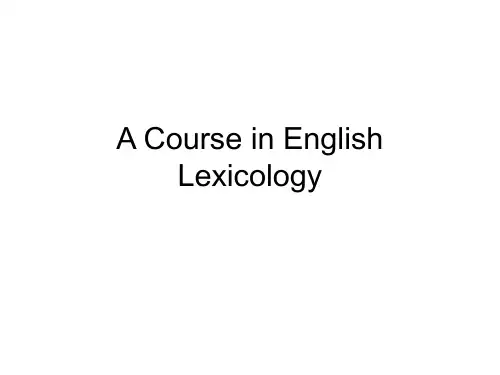
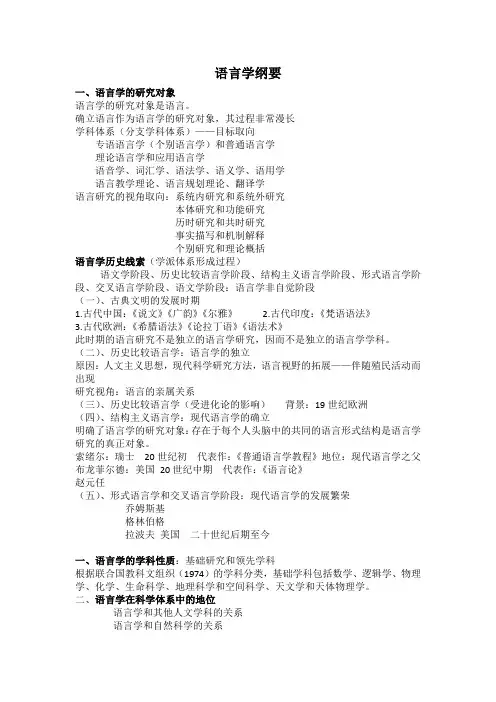
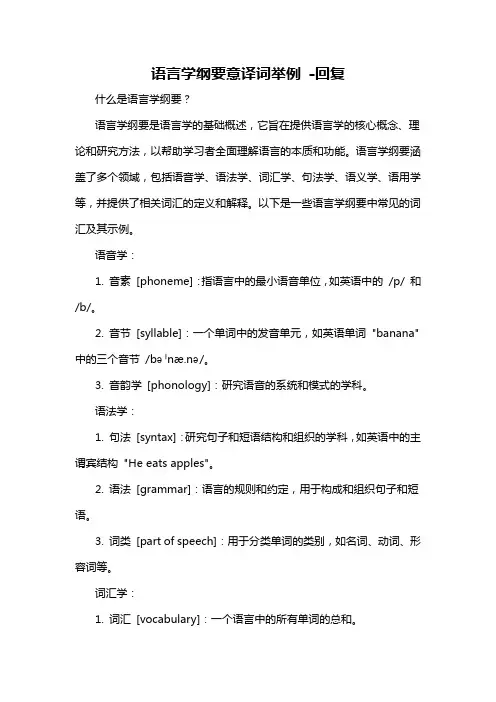
语言学纲要意译词举例 -回复 什么是语言学纲要? 语言学纲要是语言学的基础概述,它旨在提供语言学的核心概念、理论和研究方法,以帮助学习者全面理解语言的本质和功能。语言学纲要涵盖了多个领域,包括语音学、语法学、词汇学、句法学、语义学、语用学等,并提供了相关词汇的定义和解释。以下是一些语言学纲要中常见的词汇及其示例。 语音学: 1. 音素 [phoneme]:指语言中的最小语音单位,如英语中的 /p/ 和 /b/。 2. 音节 [syllable]:一个单词中的发音单元,如英语单词 "banana" 中的三个音节 /bəˈnæ.nə/。 3. 音韵学 [phonology]:研究语音的系统和模式的学科。 语法学: 1. 句法 [syntax]:研究句子和短语结构和组织的学科,如英语中的主谓宾结构 "He eats apples"。 2. 语法 [grammar]:语言的规则和约定,用于构成和组织句子和短语。 3. 词类 [part of speech]:用于分类单词的类别,如名词、动词、形容词等。 词汇学: 1. 词汇 [vocabulary]:一个语言中的所有单词的总和。 2. 同义词 [synonym]:具有相似意义的词语,如 "big" 和 "large"。 3. 反义词 [antonym]:具有相反意义的词语,如 "hot" 和 "cold"。 句法学: 1. 主语 [subject]:句子中执行动作或行为的人、事物或概念。 2. 谓语 [predicate]:句子中描述主语的动作、状态或性质的部分。 3. 宾语 [object]:句子中接受动作的人、事物或概念。 语义学: 1. 语义 [semantics]:研究词语和句子意义的学科。 2. 含义 [meaning]:词语或句子所传达的信息或概念。 3. 上位词 [hypernym]:在词语层级中具有更广泛意义的词语,如 "动物" 是 "狗" 和 "猫" 的上位词。 语用学: 1. 语用 [pragmatics]:研究语言使用背后的实际意义和交际的学科。 2. 言外之意 [implicature]:言外之意,即通过推理得出的不明确表达的意义。 3. 礼貌原则 [politeness principle]:指在语言交流中尊重他人并遵循社会礼仪的原则。 以上仅是语言学纲要中涉及的一小部分词汇,实际上,语言学纲要涵盖的范围非常广泛且深入。通过学习语言学纲要中的这些词汇,我们能更好地理解和分析语言的结构、运作方式和意义的构建,从而提高我们对不同语言的学习和应用能力。无论是研究语言现象还是学习外语,语言学纲要都是一个重要的基础知识。
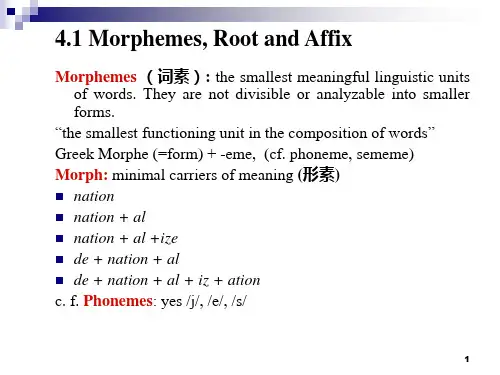
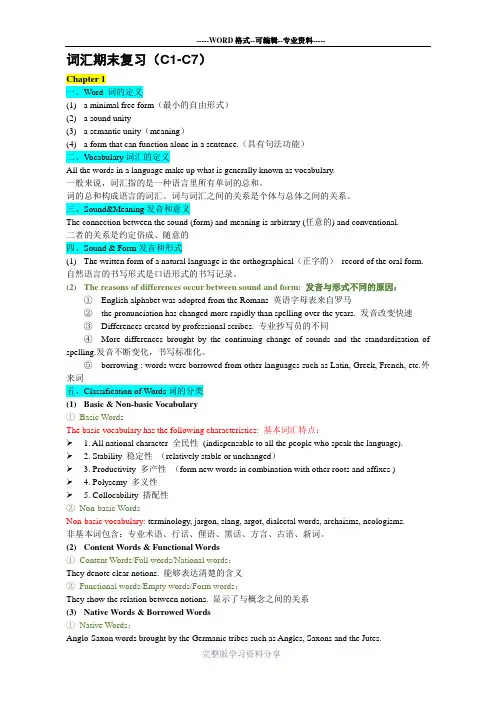
词汇期末复习(C1-C7)Chapter 1一、Word 词的定义(1) a minimal free form(最小的自由形式)(2) a sound unity(3) a semantic unity(meaning)(4) a form that can function alone in a sentence.(具有句法功能)二、V ocabulary词汇的定义All the words in a language make up what is generally known as vocabulary.一般来说,词汇指的是一种语言里所有单词的总和。
词的总和构成语言的词汇。
词与词汇之间的关系是个体与总体之间的关系。
三、Sound&Meaning发音和意义The connection between the sound (form) and meaning is arbitrary (任意的) and conventional.二者的关系是约定俗成、随意的四、Sound & Form发音和形式(1)The written form of a natural language is the orthographical(正字的)record of the oral form. 自然语言的书写形式是口语形式的书写记录。
(2)The reasons of differences occur between sound and form: 发音与形式不同的原因:①English alphabet was adopted from the Romans 英语字母表来自罗马②the pronunciation has changed more rapidly than spelling over the years. 发音改变快速③Differences created by professional scribes. 专业抄写员的不同④More differences brought by the continuing change of sounds and the standardization of spelling.发音不断变化,书写标准化。
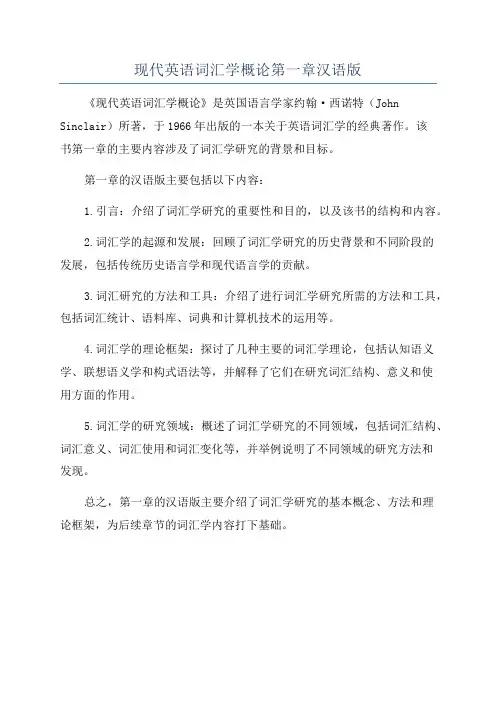
现代英语词汇学概论第一章汉语版
《现代英语词汇学概论》是英国语言学家约翰·西诺特(John Sinclair)所著,于1966年出版的一本关于英语词汇学的经典著作。
该
书第一章的主要内容涉及了词汇学研究的背景和目标。
第一章的汉语版主要包括以下内容:
1.引言:介绍了词汇学研究的重要性和目的,以及该书的结构和内容。
2.词汇学的起源和发展:回顾了词汇学研究的历史背景和不同阶段的
发展,包括传统历史语言学和现代语言学的贡献。
3.词汇研究的方法和工具:介绍了进行词汇学研究所需的方法和工具,包括词汇统计、语料库、词典和计算机技术的运用等。
4.词汇学的理论框架:探讨了几种主要的词汇学理论,包括认知语义学、联想语义学和构式语法等,并解释了它们在研究词汇结构、意义和使
用方面的作用。
5.词汇学的研究领域:概述了词汇学研究的不同领域,包括词汇结构、词汇意义、词汇使用和词汇变化等,并举例说明了不同领域的研究方法和
发现。
总之,第一章的汉语版主要介绍了词汇学研究的基本概念、方法和理
论框架,为后续章节的词汇学内容打下基础。

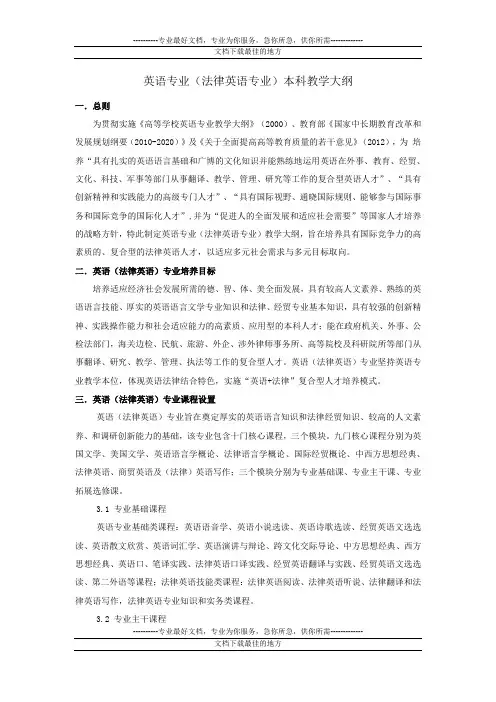
英语专业(法律英语专业)本科教学大纲一.总则为贯彻实施《高等学校英语专业教学大纲》(2000)、教育部《国家中长期教育改革和发展规划纲要(2010-2020)》及《关于全面提高高等教育质量的若干意见》(2012),为培养“具有扎实的英语语言基础和广博的文化知识并能熟练地运用英语在外事、教育、经贸、文化、科技、军事等部门从事翻译、教学、管理、研究等工作的复合型英语人才”、“具有创新精神和实践能力的高级专门人才”、“具有国际视野、通晓国际规则、能够参与国际事务和国际竞争的国际化人才”,并为“促进人的全面发展和适应社会需要”等国家人才培养的战略方针,特此制定英语专业(法律英语专业)教学大纲,旨在培养具有国际竞争力的高素质的、复合型的法律英语人才,以适应多元社会需求与多元目标取向。
二.英语(法律英语)专业培养目标培养适应经济社会发展所需的德、智、体、美全面发展,具有较高人文素养、熟练的英语语言技能、厚实的英语语言文学专业知识和法律、经贸专业基本知识,具有较强的创新精神、实践操作能力和社会适应能力的高素质、应用型的本科人才;能在政府机关、外事、公检法部门,海关边检、民航、旅游、外企、涉外律师事务所、高等院校及科研院所等部门从事翻译、研究、教学、管理、执法等工作的复合型人才。
英语(法律英语)专业坚持英语专业教学本位,体现英语法律结合特色,实施“英语+法律”复合型人才培养模式。
三.英语(法律英语)专业课程设置英语(法律英语)专业旨在奠定厚实的英语语言知识和法律经贸知识、较高的人文素养、和调研创新能力的基础,该专业包含十门核心课程,三个模块。
九门核心课程分别为英国文学、美国文学、英语语言学概论、法律语言学概论、国际经贸概论、中西方思想经典、法律英语、商贸英语及(法律)英语写作;三个模块分别为专业基础课、专业主干课、专业拓展选修课。
3.1 专业基础课程英语专业基础类课程:英语语音学、英语小说选读、英语诗歌选读、经贸英语文选选读、英语散文欣赏、英语词汇学、英语演讲与辩论、跨文化交际导论、中方思想经典、西方思想经典、英语口、笔译实践、法律英语口译实践、经贸英语翻译与实践、经贸英语文选选读、第二外语等课程;法律英语技能类课程:法律英语阅读、法律英语听说、法律翻译和法律英语写作,法律英语专业知识和实务类课程。

英语词汇学笔记整理Chapter 11 - The definition of a word comprises the following points:(1) a minimal free form of a language;(2) a sound unity;(3) a unit of meaning;(4) a form that can function alone in a sentence.A word is a minimal free form of a language that has a given sound and meaning and syntactic function.2- Sound and Meaning: symbolic connection is almost always arbitrary and conventional.A dog is called a dog not because the sound and the three letters that make up the word just automatically suggest the animal in question.3- Old English, the speech of the time was represented very much more faithfully in writing than it is today. The internal reason for this is that the English alphabet was adopted from the Romans, which does not have a separate letter to represent each sound in the language so that some letters must do double duty or work together in combination.Another reason is that the pronunciation has changed more rapidly than spelling over the years, and in some cases the two have drawn far apart.4-A third reason is that some of the differences were created by the early scribes. Finally comes the borrowing, which is an important channel of enriching the English vocabulary.5 - Vocabulary: All the words in a language make up its vocabulary. Not only can it refer to the total number of the words in a language, but it can stand for all the words used in a particular historical period. We also use it to refer to all the words of a given dialect, a given book, a given discipline and the words possessed by an individual person. The general estimate of the present-day English vocabulary is over million words.words used in a particular historical period. We also use it to refer to all the words of a given dialect, a given book, a given discipline and the words possessed by an individual person. The general estimate of the present-day English vocabulary is over million words.words used in a particular historical period. We also use it to refer to all the words of a given dialect, a given book, a given discipline and the words possessed by an individual person. The general estimate of the present-day English vocabulary is over million words.words used in a particular historical period. We also use it to refer to all the words of a given dialect, a given book, a given discipline and the words possessed by an individual person. The general estimate of the present-day English vocabulary is over million words.6 - Words may fall into the basic word stock and nonbasic vocabulary by use frequency, into content words and functional words by notion, and into native words and borrowed words by origin.7 - The basic word stock is the foundation of the vocabulary accumulated over centuries and forms the common core of the language. Though words of the basic word stock constitute a small percentage of the English vocabulary, yet it is the most important part of it. These words have obvious characteristics.8 - All national character. Words of the basic word stock denote the most common things and phenomena of the world around us, which are indispensable to all the people who speak the languageNatural phenomena/Human body and relations/Names of plants and animals/Action, size, domain, state/Numerals, pronouns, prepositions, conjunctions9 - Stability. Words of the basic word stock have been in use for centuries.10 - Productivity . Words of the basic word stock are mostly root words or monosyllabic words. They can each be used alone, and at the same time can form new words with other roots and affixes.11 - Polysemy. Words belonging to the basic word stock often possess more than one meaning because most of them have undertone semantic changes in the course of useand become polysemous.12 - Collocability . Many words of the basic word stock quite a number of set expressions, idiomatic usages, proverbial sayings and the like.13 - Terminology consists of technical terms used in particular disciplines and academic areas .14 - Jargon refers to the specialized vocabularies by which members of particular arts, sciences, trades and professions communicate among themselves such as in business.15 - Slang belongs to the sub-standard language, a category that seems to stand between the standard general words including informal ones available to everyone and in-group words like cant, jargon, and argot, all of which are associated with, or most available to, specific groups of the population.Slang is created by changing or extending the meaning of existing words though some slang words are new coinages altogether. Slang is colourful, blunt, expressive and impressive.16 - Argot generally refers to the jargon of criminals.17 - Dialectal words are words used only by speakers of the dialect in question.18 - Archaisms are words or forms that were once in common use but are now restricted only to specialized or limited use.19 - Neologisms are newly-created words or expressions, or words that have taken on new meanings.20 - By notion, words can be grouped into content words and functional words. Content words denote clear notions and thus are known as notional words. They include nouns, verbs, adjectives, adverbs and numerals, which denote objects, phenomena, action, quality, state, degree, quantity.21 - Functional words do not have notions of their own. Therefore, they are also called empty words. As their chief function is to express the relation between notions, the relation between words as well as between sentences, they are known as formwords. Prepositions, conjunctions, auxiliaries and articles belong to this category.22 - However, functional words do far more work of expression in English on average than content words.23 - Native words are words brought to Britain in the fifth century by the German tribes; the Angles, the Saxons, and the Jutes, thus known as Anglo-Saxon words.24 - Apart from the characteristics mentioned of the basic word stock, in contrast to borrowed words, native words have two other features:Neutral in style. they are not stylistically specific.Stylistically, natives words are neither formal nor informal whereas the words borrowed from French or Latin are literary and learned, thus appropiate in formal style.Frequent in use. Native words are most frequently used in everyday speech and writing.25 - Words taken over from foreign languages are known as borrowed words or loan words or borrowings in simple terms. It is estimated that English borrowings constitute 80 percent of the modem English vocabulary. The Englishlanguage is noted for the remarkable complexity and heterogeneity of its vocabulary because of its extensive borrowings26 - Aliens are borrowed words which have retained their original pronunciation and spelling. These words are immediately recognizable as foreign in origin.27 - Semantic-loans. Words of this category are not borrowed with reference to the form. But their meanings are borrowed. In other words, English has borrowed a new meaning for an existing word in the language.Chapter 21 - It is assumed that the world has approximately 3, 000 (some put it 5, 000 ) languages, which can be grouped into roughly 300 language families on the basis of similarities in their basic word stock and grammar.2 - The Indo-European is one of them. It is made up of most of the languages of Europe, the Near East, and India.3 - They accordingly fall into eight principal groups, which can be grouped into an Eastern set: Balto-Slavic , Indo-Iranian , Armenian and Albanian ; a Western set: Celtic, Italic, Hellenic, Germanic.4 - In the Eastern set, Armenian and Albanian are each the only modern language respectively. The Balto-Slavic comprises such modern languages as Prussian, Lithuanian, Polish, Czech, Bulgarian, Slovenian and Russian.5 - In the Indo-Iranian we have Persian. Bengali, Hindi, Romany, the last three of which are derived from the dead language Sanskrit.6 - In the Western set, Greek is the modern language derived from Hellenic.7 - The Germanic family consists of the four Northern European Languages: Norwegian, Icelandic, Danish and Swedish, which are generally known as Scandinavianlanguages. Then there is German, Dutch, Flemish and English.languages. Then there is German, Dutch, Flemish and English.8 - Old English (450-1150)Anglo-Saxon as Old English. Old English has a vocabulary of about 50, 000 to 60, 000 words. It was a highly inflected language just like moderm German.Anglo-Saxon as Old English. Old English has a vocabulary of about 50, 000 to 60, 000 words. It was a highly inflected language just like moderm German.9 - Middle English (1150-1500)Although there were borrowings from Latin, the influence on English was mainly Germanic.Between 1250 and 1500 about 9000 words of French origin poured into English. Seventy-five percent of them are still in use today.If we say that Old English was a language of full endings. Middle English was one of leveled endings.10 - Modern English (1500-up to now)Modern English began with the establishment of printing in England.Early (1500-1700) and Late (1700-up to the present) Modern EnglishModern English began with the establishment of printing in England.Early (1500-1700) and Late (1700-up to the present) Modern EnglishIn the early period of Modern English, Europe saw a new upsurge of learning ancient Greek and Roman classics. This is known in history as the Renaissance.Latin and Greek were recognized as the languages of the Western world’’s great literary heritage and of great scholarshipIn fact, more than twenty-five per cent of modern English words come almost directly from classical languages.It can be concluded that English has evolved from a synthetic language (Old English) to the present analytic language.11 - Three main sources of new words: the rapid development of modern science and technology(45%); social, economic and political changes(24%);the influence of other cultures and languages(11%).the influence of other cultures and languages(11%).12 - Modern English vocabulary develops through three channels: creation, semantic change, borrowing.Creation refers to the formation of new words by using the existing materials, namely roots, affixes and other elements. In modern times, this is the most important way of vocabulary expansion.Semantic change means an old form which takes on a new meaning to meet the new need. This does not increase the number of word forms but create many more new usages of the words, thus enriching the vocabulary.Borrowing has played a vital role in the development of vocabulary, particularly in earlier times. Borrowed words constitute merely six to seven percent of all new worlds. In earlier stages of English, frnch, greek and Scandinavian were the major contributiors.Reviving archaic or obsolete words(复活古词和废弃词) also contributes to the growth of English vocabulary though quite insignificant.Chapter 31 - These different forms occur owing to different sound environment. These minimal meaningful units are known as morphemes.In other words, the morpheme is "the amallest functioning unit in the composition of words"In other words, the morpheme is "the amallest functioning unit in the composition of words"2 - Morphemes are abstract units, which are realized in speech by discrete units known as morphs. They are actual spoken , minimal carriers of meaning. The morpheme is to the morph what a phoneme is to a phone.3 - These morphemes coincide with words as they can stand by themselves and function freely in a sentence. Words of this kind are called monomorphemic words.4 - Some morphemes, however, are realized by more than one morph according to their position in a word. Such alternative morphs are known as allomorphs.5 - There are cases where the allomorphs of the plural morpheme are realized by the change of an internal vowel or by zero morph.6 - Free Morphemes which are independent of other morphemes are considered to be free. These morphemes have complete meanings in themselves and can be used as free grammatical units in sentences. They are identical with root words, as each of them consists of a single free root, we might as well say that free morphemes are free roots.7 - Bound Morphemes which cannot occur as separate words are bound. They are so named because they are bound to other morphemes to form words. Bound morphemes are chiefly found in derived words.8 - Bound morphemes include two types: bound root and affix.Bound root is that part of the word that carries the fundamental meaning just like a free root. Unlike a tree root, it is a bound form and has to combine with other morphemes to make words.In English, bound roots are either Latin or Greek. Although they are limited in number, their productive power is amazing.Bound root is that part of the word that carries the fundamental meaning just like a free root. Unlike a tree root, it is a bound form and has to combine with other morphemes to make words.In English, bound roots are either Latin or Greek. Although they are limited in number, their productive power is amazing.Affixes are forms that are attached to words or word elements to modify meaning or function. According to the functions of affixes, we can put them into two groups; inflectional and derivational affixes.Affixes attached to the end of words to indicate grammatical relationships are inflectional, thus known as inflectional morphemes. The number of inflectional affixes is small and stable.Derivational affixes. As the term indicates, derivational affixes are affixes added to other morphemes to create new words. Derivational affixes can be further divided into prefixes and suffixes. Prefixes come before the ward and the suffixes after the word.9 - A root is the basic form of a word which cannot be further analysed without total loss of identity. The root, whether free or bound, generally carries the main component of meaning in a word. Root is that part of a wordform that remains when all inflectional and derivational affixes have been removed.10 - A stem may consist of a single root morpheme as in iron or of two root morphemes as in a compound like handcuff. It can be a root morpheme plus one or more affixational morphemes as in mouthful.A stem can be defined as a form to which affixes of any kind can be added。
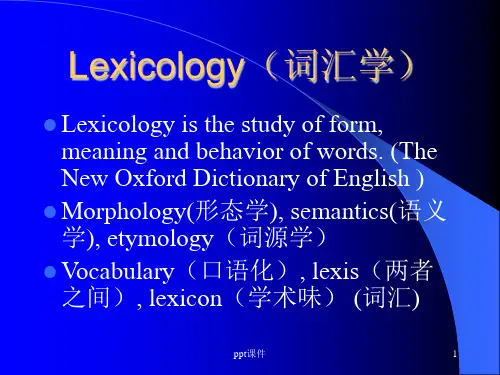
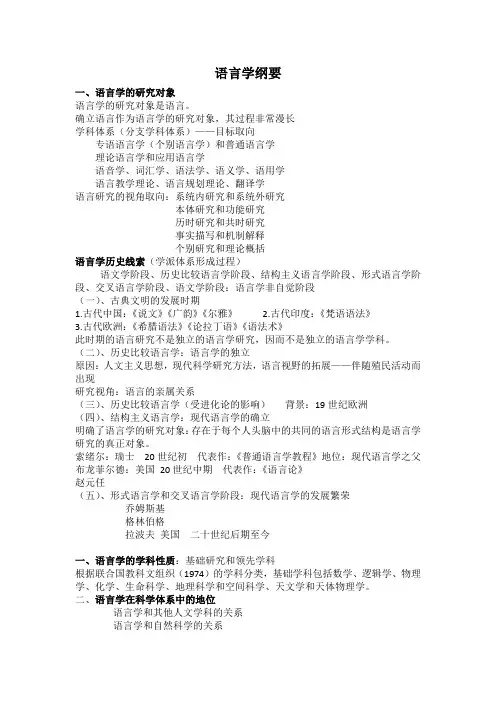
语言学纲要一、语言学的研究对象语言学的研究对象是语言。
确立语言作为语言学的研究对象,其过程非常漫长学科体系(分支学科体系)——目标取向专语语言学(个别语言学)和普通语言学理论语言学和应用语言学语音学、词汇学、语法学、语义学、语用学语言教学理论、语言规划理论、翻译学语言研究的视角取向:系统内研究和系统外研究本体研究和功能研究历时研究和共时研究事实描写和机制解释个别研究和理论概括语言学历史线索(学派体系形成过程)语文学阶段、历史比较语言学阶段、结构主义语言学阶段、形式语言学阶段、交叉语言学阶段、语文学阶段:语言学非自觉阶段(一)、古典文明的发展时期1.古代中国:《说文》《广韵》《尔雅》2.古代印度:《梵语语法》3.古代欧洲:《希腊语法》《论拉丁语》《语法术》此时期的语言研究不是独立的语言学研究,因而不是独立的语言学学科。
(二)、历史比较语言学:语言学的独立原因:人文主义思想,现代科学研究方法,语言视野的拓展——伴随殖民活动而出现研究视角:语言的亲属关系(三)、历史比较语言学(受进化论的影响)背景:19世纪欧洲(四)、结构主义语言学:现代语言学的确立明确了语言学的研究对象:存在于每个人头脑中的共同的语言形式结构是语言学研究的真正对象。
索绪尔:瑞士20世纪初代表作:《普通语言学教程》地位:现代语言学之父布龙菲尔德:美国20世纪中期代表作:《语言论》赵元任(五)、形式语言学和交叉语言学阶段:现代语言学的发展繁荣乔姆斯基格林伯格拉波夫美国二十世纪后期至今一、语言学的学科性质:基础研究和领先学科根据联合国教科文组织(1974)的学科分类,基础学科包括数学、逻辑学、物理学、化学、生命科学、地理科学和空间科学、天文学和天体物理学。
二、语言学在科学体系中的地位语言学和其他人文学科的关系语言学和自然科学的关系语言学是自然科学和人文社会科学联系的桥梁。
语言学的应用价值解读经典,传承文化。
为语言文字的教学服务。
(本族语、外语教学)语言文字的翻译。
Semantics is the study of meaning. More specifically, semantics is the study of the meaning of linguistic units, words and sentences in particular.The theory of meaning which relates the meaning of a word to the thing it refers to, or stands for, is known as the Referential Theory.The naming theory命名说According to it, the linguistic forms or symbols or words used in a language are simply labels of the objects they stands for. So words are just names or labels for things.It is also called the referential theory (指称论).Theory of the context of situation [ J. R. Firth (1890-1960) ]情景语境①The relevant features of the participants, persons, personalities.②The relevant objects.③The effects of the verbal action.The conceptualist view概念理论This view holds that there is no direct link between a linguistic form and what it refers to; rather, in the interpretation of meaning they are linked through the mediation of concepts in the mind.It is also called ideational theory(观念论)Contextualism语境J. R. Firth 费斯The linguists hold that meaning should be studied in terms of situation, use, context—elements closely linked with language behavior.Behaviorism行为主义This theory, somewhat close to contextualism, is linked with psychological interest. This view of meaning proposed by Bloomfield is illustrated by his story about Jack and Jill.According to Bloomfield, the meaning of a linguistic form should be viewed as “the situation in which the speaker utters it, and the response which it calls forth in the hearer.”The Definition of senseSense refers to the inherent meaning of the linguistic form; it is concerned only with intra-linguistic relations.The definition of referenceReference means what a linguistic form refers to in the real, physical world;it deals with the relationship between the linguistic element and the non-linguistic world of experience.What is culture?Broadly speaking, it means the total way of life of people, including the patterns of belief, customs, objects, institutions, techniques, and language.In a narrow sense, it refers to local or specific practice, beliefs or customs.Anthropological study of linguistics: study of language in a sociocultural context.Sapir-Whorf Hypothesis定义Our language helps mould our way of thinking and, consequently, different languages may probably express speakers’ unique ways of understanding the world. Linguistic determinism: L may determine our thinking patterns.Linguistic relativity: different languages offer people different ways of expressing the world around.SociolinguisticsThe sub-field of linguistics that studies the relation between language and society, between the uses of language and the social structures in which the users of language live.Variationist perspective: 变异视角Variety 的定义People who claim to be users of the same language do not speak the language in the same manner.Dialect定义Varieties (变体)related to the user are normally known as dialectsRegister定义In linguistics, a register is a variety of a language used for a particular purpose or ina particular social setting.1. Regional dialects are linguistic varieties used by people living in different regions.2. Social-class dialect, or sociolect 社会方言, refers to the linguistic variety characteristic of a particular social class.3.Idiolect个人方言A personal dialect of an individual speaker that combines elements regarding regional, social, gender and age variations.4. Ethnic dialect种族方言A variety of language that is mainly spoken by a less privileged population that has experience some form of social isolation such as racial discrimination or segregation5. Standard dialect:Diglossia: Two distinct varieties of the same language are used, side by side, for two different sets of functionsMonolingual: Speakers of a single language control different varieties of that language. Bilingual: People develop some ability in a second language.High Context Culture:-Cultures that rely heavily on non-verbal and subtle situational cues in communication.Low Context Culture:- Cultures that rely heavily on words to convey meaning in communication. Definition of PragmaticsThe study of language in use.The study of meaning in context.The study of speakers’ meaning, utterance meaning,& contextual meaning.Performatives: utterances which are used to perform acts, do not describe or report anything at all; the uttering of the sentence is the doing of an action; they cannot be said to be true or false. Constatives: utterances which roughly serves to state a fact, report that something is the case, or describe what something is.Conversational Implicaturea type of implied meaning, which is deduced on the basis of the conversational meaning of words together with the context, under the guidance of the CP and its maxims【Herbert Paul Grice (1913-1988)】The Cooperative Principle (CP)Make your conversational contribution such as required at the stage at which it occurs by the accepted purpose or direction of the talk exchange in which you are engaged.Applied linguistics is an interdisciplinary field of study that identifies, investigates, and offers solutions to language-related real-life problemsIn linguistics, the theory of universal grammar holds that there are certain fundamental grammatical ideas which all humans possess, without having to learn them.Krashen’s Input HypothesisLearners acquire language as a result of comprehending input addressed to them.“i+1” principleThe language that learners are exposed to should be just far enough beyond their current competence so that they can understand most of it but still be challenged to make progress.The type of language constructed by second or foreign language learners who are still in the process of learning a language is often referred to as interlanguage.Communicative competence{Dell Hymes}What a learners knows about how a language is used in particular situations for effective and appropriate communicationTypes of syllabus The structural syllabus,The situational syllabus,The communicative syllabus,The task-based syllabusContrastive AnalysisA way of comparing the first language and the second language to determine potential errors for the ultimate purpose of isolating what needs to be learned and what does not need to be learned in a second language learning situation. (Gass and Selinker, 2001:72)Error Analysis Many errors made by the second language learners were caused by factors other than the first language interference.Error: learner’s lack of knowledge/ competenceMistake: learner’s failure to perform their competence填空This is best illustrated by the semantic triangle suggested by Ogden and RichardsThere are generally three kinds of sense relations recognized, namely, sameness relation (相似关系), oppositeness relation (对立关系)inclusiveness relation (内含)Characteristics of implicature1) Calculability 可推导性2) Cancellability可取消性(依赖语境)3) Non-detachability不可分离性(依赖语义)4) Non-conventionality非规约性【Two variables concerning the amenability of language elements to focus on form are the relevance of Universal Grammar (UG) and the complexity of language structures.】Leech七分法 1. 概念意义(conceptual)2. 内涵意义(connotative)3. 社会意义(social)4. 情感意义(affective)5. 反射意义(reflective)6. 搭配意义(collocative)7. 主题意义(thematic)。
英语构词法摘要:语言随着社会发展而发展,其中词汇又是语言学习过程中基本内容之一,学好词汇往往能在语言学习过程中取得事半功倍的效果。
现代英语词汇的发展主要依靠构词法,英语构词法可以帮助我们辨认单词、理解词意,并迅速扩大词汇量。
本文主要介绍转化法、派生法、合成法、混合法、截短法和首位字母结合法六大英语构词法说明英语构词方式和特点。
关键词:语言学;构词法;转化法;派生法;合成法;混合法;截短法;首位字母结合法1.引言随着社会的发展和进步,越来越多的人开始重视英语的学习和研究。
在此过程中,有些旧词被丢弃,又根据需要创造出一些新词,于是英语的学习也不知不觉增加了难度,如何快速准确地学习并掌握英语便成了重要问题。
一般来说,无论在哪种语言学习中,词汇都是基础部分,那么要如何准确辨认单词、理解词意并扩大词汇?正确掌握构词法便是扩大词汇量的一个有效方法。
什么是构词法呢?语言是随着人类社会的不断发展而发展的,一些旧词的过时意味着需要人们创造出一些新的词,而新词的产生,也大体上服从一定规则,有其规律可循。
人们根据这些规律创造出新的词汇表示新生事物和概念,这种造词的方法在语言中就叫做构词法。
英语的构词法主要可以分为转化法、派生法、合成法、混合法、截短法和首位字母结合法六种。
本文介绍的这六种构词法可帮助人们科学简洁且有效地记忆单词。
2.文献综述关于词的界定,不同学者有不同的标准。
Bloomfield(1933)以句子结构为基础,将词确定为“最小的自由形式”,即能够独立构成一个语段的最小的单位。
《辞海》给出词的定义是“今指语言组织中的基本单位,能独立运用,具有声音、意义和语法功能。
”《现代汉语词典》给出的定义是:“一种语言中所使用的词的总和,是构造语言的材料。
”汪榕培(2002)把词定义为不可分割的结构单位,由一个或几个词素构成,通常在短语结构中出现。
根据这个定义,英语词有如下四个特点:词是不可分隔的单位,词可以由一个或几个词素构成,词通常出现在短语结构中,以及词应该属于某个词类。
语言学纲要意译词举例-回复标题:语言学纲要意译词举例:揭示语言背后的意义引言:语言是人类的重要交流方式,而研究语言的学科便是语言学。
语言学纲要是语言学中的重要组成部分,它探讨大量与语言相关的主题,并提供了有助于理解语言本质的重要概念和术语。
本文将以中括号内的内容为主题,为您详细阐述并举例解释语言学纲要中的意译词,以揭示语言背后的丰富意义。
一、[语音学]:音素(Phoneme)在语音学中,音素是对语音中最小的、区别词意的发音单元的抽象概念进行意译的词汇。
不同的音素构成了语言的音位系统,并且这些音素的组合决定了不同音节和单词的发音。
例如,英语中的/b/和/p/是两个不同的音素,它们可以对词义产生重要影响,如"bat"(球拍)和"pat"(拍)。
二、[词汇学]:同义词(Synonym)词汇学涉及词汇的形成、意义和用法。
同义词是指具有相似或近似意义的词语。
当我们在表达时希望避免重复使用某个词时,可以通过使用同义词来增加表达的多样性。
例如,"快乐"和"愉快"是中文中的两个同义词,它们都表示情绪上的愉悦。
三、[句法学]:主谓宾(Subject-Verb-Object)句法学是研究句子结构和组织的学科。
主谓宾是一种句子的基本结构,其中主语是动作的执行者,谓语是动作的核心内容,而宾语是动作的承受者。
例如,英语中的句子"She eats an apple."(她吃一个苹果。
)遵循了主谓宾结构。
四、[语义学]:语义角色(Semantic Role)语义学是研究语言中词语和句子意义的学科。
语义角色是指在句子中扮演不同角色的成分,它们描述了事件或动作中不同参与者的关系。
例如,在句子"The cat chased the mouse."(猫追逐老鼠。
)中,"猫"是执行追逐动作的"动作者",而"老鼠"是动作的"承受者"。
英语词汇学基本概念汇总《英语词汇学》重要术语One:1. Native words 本族词Words of Anglo-Saxon origin or of Old English are native words.2. Loan words 借词Words borrowed from other languages are loan words or borrowed words.3. Slang words 俚语Slang words are those words of a vigorous, colourful, facetious, or taboo nature, invented for specific occasions, or uses, or derived from the unconventional use of the standard vocabulary.4. Function words 功能词Function words are often short words such as determiners, conjunctions, prepositions, auxiliaries that serve grammatically more than anything else.5. Content words 实义词Content words areused to name objects, qualities, actions, processes or states, and have independent lexical meaning.6. Free forms 自由形式Forms which occur as sentences are free forms.Two:1. Morphemes 语素Morphemes are the smallest meaningful linguistic units of English language, not divisible or analyzable into smaller forms.2. Allomorphs 语素变体Allomorphs are any of the variant forms of a morpheme as conditioned by position or adjoining sounds.3. Free morpheme 自由语素Free morpheme is one that can be uttered alone with meaning.4. Bound morpheme 粘着语素Boundmorpheme cannot stand by itself as a complete utterance and must appear with at least one other morpheme, free or bound.5. Root 词根Root is the basic unchangeable part of a word and it conveys the main lexical meaning of the word.6. Affix 词缀Affix is a collective term for the type of formative that can be used only when added to another morpheme.7. Inflectional affix 屈折词缀Inflectional affix serves to express such meanings as plurality, tense, and the comparative or superlative degree.8. Derivational affix 派生词缀Derivational affix is the kind of affixes that has specific lexical meaning hand can derive a word when it is added to another morpheme.9. Prefixes 前缀Prefixes are affixes added before words.10. Suffixes 后缀Suffixes are affixes added after words.Three1. Word-formation rules 构词规则Word-formation rules define the scope and methods whereby speakers of a language may create new words.2. Stem 词干Stem is the part of the word-form which remains when all inflectional affixes have been removed.3. Base 词基Base is any form to which affixes of any kind can be added.4. Compounding 合成法Compounding is a word-formation process consisting of joining two or more bases to form a new unit.5. Derivation 派生法Derivation or affixation is a word-formation process by which new words are created by adding a prefix, or suffix, or both, to the base.6. Conversion 转化法Conversion is a word-formation process whereby a word of a certain word-class is shifted into a word of another word-class without the addition of an affix.7. Prefixation 前缀法Prefixation is the addition of a prefix to the base.8. Suffixation 后缀法Suffixation refers to the addition of a suffix to the base.Four:1. Initialism 首字母连写词Initialism is a type of shortening, using the first letters of words to form a proper name, a technical term or a phrase and it is pronounced letter by letter.2. Acronyms首字母拼音词Acronyms are word formed from the initial letters of the name of an organization or a scientific term, and they are pronounced as words rather than as sequences of letters.3. Clipping 截短法The process of clipping involves the deletion of one or more syllables from a word (usually a noun), which is also available in its full form.4. Blending 拼缀法Blending is a process of word-formation in which a new word is formed by combining the meanings and sounds of two words, one of which is not in its full form or both of which are not in their full forms.5. Back-formation 逆成法Back-formation is a type of word-formation by which a shorter word is coined by the deletion of asupposed affix from a longer form already present in the language.6. Reduplication 重叠法Reduplication is a minor type of word-formation by which a compound word is created by therepetition of one word or of two almost identical words with a change in the vowels or of two almost identical words with a change in the initial consonants.7. Neoclassical formation 新古典词构成法Neoclassical formation is the process by which new words are formed from elements derived from Latin and Greek.Five:1. Conventionality 约定俗成It is the characteristics of relation between the sound-symbol and its sense: there is no way to explain why this or that sound-symbol has this or that meaning beyond the fact that the people of a given community have agreed touse one to designate the other.2. Motivation 理据Motivation refers to the direct connection between word-symbol and its sense.3. Echoic/ onomatopoeic words 拟声词Echoic words or onomatopoeic words are words motivated phonetically whose pronunciation suggests the meaning.4. Morphological motivation 语素结构理据A word is morphologically motivated if a direct connection can be observed between the morphemic structure of the word and its meaning.5. Semantic motivation 语义理据Semantic motivation refers to motivation based on semantic factors and it is usually provided by the figurative usage of words.6. Grammatical meaning 语法意义Grammatical meaning consists of word-class and inflectional paradigm.7. Inflectional paradigm 词形变化The set of grammatical forms of a word is called its inflectional paradigm. Nouns are declined, verbs are conjugated and gradable adjectives have degrees of comparison.8. Denotative meaning 外延意义The denotative meaning of a word is its definition given in a dictionary.9. Connotative meaning 内涵意义Connotative meaning refers to the emotional association which a word or a phrase suggests in one’s mind.10. Social or stylistic meaning 社会意义Social meaning is that which a piece of language conveys about the socialcircumstances of its use.11. Affective meaning 情感意义Affective meaning is concerned with the expression of feelings and attitudes of the speaker or writer.12. Componential analysis 语义成分分析The conceptual meaning or denotative meaning can be broken down into its minimal distinctive components which are known as semantic features. Such an analysis is called componential analysis.Six:1. Polysemy 一词多义Polysemy happens when more than one meaning is attached to a word.2. Radiation 词义辐射Semantically, radiation is the process in which the primaryor central meaning stands at the center while secondary meanings radiate from it in every direction like rays.3. Concatenation 语义的连锁、联结Concatenation is a semantic process in which the meaning of a word moves gradually away from its first sense by successive shifts, like the links of a chain, until there is no connection between the sense that is finally developed and the primary meaning.4. Homonymy 同音异义、同形异义Homonymy is the relation between pairs or groups of word which, though different in meaning, are pronounced alike, or spelled alike or both.5. Perfect homonyms 完全同音同形异义词Words identical in sound and spelling but different in meaning are called perfect homonyms.6. Homophones 同音异义词Wordsidentical in sound but different in spelling and meaning are called homophones. 7. Homographs 同形异义词Words identical in spelling but different in sound and meaning are called homographs.8. Phonetic convergence 音变的汇合Phonetic convergence is the kind of phenomenon where two or more words which once were different in sound forms take on the same pronunciation.9. Semantic Divergence 词义分化When two or more meanings of the same word drift apart to such an extent that there will be no obvious connection between them, the word has undergone the process of semantic divergence.Seven: 1. Synonyms 同义词 A synonym may be defined as a word having the same meaning as another word: as one of two ormore words of the same language and grammatical category having the same essential or generic meaning and differing only in connotation, application, or idiomatic use. 2. Complete synonyms 完全同义词Two words are totally synonymous only if they are fully identical in meaning and interchangeable in any context without the slightest alteration in connotative, affective and stylistic meanings. 3. Relative synonyms 相对同义词Relative synonyms are words that are not fully identical but may differ in shades of meaning, in emotional colouring, in level of formality, in collocation, and in distribution. 4. Antonymy 反义关系In its general sense, antonymy refers to all types of semantic oppositeness. 5. Contraries/gradable antonyms 相对性反义词Contraries or contrary terms display such a type of semantic contrast that they can be handled in terms of gradability, that is, in terms of degrees of the quality involved. 6.Complementaries/contradictory terms 互补性反义词Complementaries or contradictories represent a type of binary semantic opposition so that theassertion of one of the items implies the denial of the other. 7. Conversives/converses/relational opposites 换位性反义词Conversives represent such a type of binary semantic opposition that there is an interdependence of meaning, or say, one member of the pair presupposes the other. 8. Hyponymy 上下义关系Hyponymy is the relationship which obtains between specific and general lexical items, such that the former is included in the latter. 9. Superordinates 上义词The general term in a hyponymy pair is called a superordinate linguistically. 10. Hyponyms 下义词The specific term in a hyponymy pair is called the hyponym or subordinate. 11. Semantic field 语义场Semantic field theory is concernedwith the vocabulary of a language as a system of interrelated lexical networks. The words of a semantic field are joined together by a common concept, and they are likely to have a number of collocations in common. Eight: 1. Context 语境Context in its narrowest sense consists of the lexical items that come immediately before and after any word in an act of communication. But, in broader sense, it may cover the whole passage and sometimes the whole book in which a word occurs, and in some cases even the entire social or cultural setting. 2. Linguistic context 语言语境Linguistic context is lexical, grammatical and verbal context in its broad sense. 3. Extra-linguistic context 语言之外的环境Extra-linguistic context refers not only to the actual speech situation in which a word is used but also to the entire cultural background against which a word, or an utterance or a speech event is set. 4. Lexical context 词汇语境Lexicalcontext refers to the lexical items combined with a given polysemous word. 5. Grammatical context 语法语境In grammatical context, the syntactic structure of the context determines various individual meanings of a polysemous word. 6. Verbal context 言语语境The verbal context, in its broadest sense, may cover an entire passage, or even an entire book, and in some cases even the entire social or cultural setting. 7. Ambiguity 歧义Ambiguity refers to a word, phrase, sentence or group of sentences with more than one possible interpretation or meaning. 8. Lexical ambiguity 词汇歧义Lexical ambiguity is caused by polysemy. 9. Structural ambiguity 结构歧义Structural ambiguity arises from the grammatical analysis of a sentence or a phrase.Nine: 1. Change of word meaning 语义变化When a word loses its old meaning and comes to refer to something altogether different, the result is a change of wordmeaning. Broadly speaking, change of meaning refers to the alteration of the meaning of existing words as well as the addition of new meaning to establish words.2. Restriction of meaning 语义专门化Restriction of meaning or specialization of meaning means that a word of wide meaning acquires a narrower, specialized sense which is applicable to only one of the objects it had previously denoted.3. Extension of meaning 词义扩展化Extension of meaning or generalization means the widening of a word’s sense until it covers much more than what it originally conveyed.4. Degeneration of meaning 词义降格There are two main forms of degeneration or pejoration. One refers to the process where words once respectable or neutral may shift to a less respectable, or even derogatory meaning. The other refers to the weakening of meaning resulting from habitual use of particular words on unsuitable occasions.5. Elevationof meaning 词义升格It refers to the process that the meaning of a word goes uphill. 6. Metaphor 暗喻Metaphor is a figure of speech containing an implied comparison based on association of similarity, in which a word or a phrase ordinarily and primarily used for one thing is applied to another. 7. Metonymy 转喻It is a figure of speech by which an object or idea is described by the name of something closely related to it. Ten: 1. Idiom 习语An English idiom is a group of words with a special meaning different from the meanings of its constituent words. It is a combination of two or more words which are usually structurally fixed and semantically opaque, and function as a single unit of meaning. 2. Phrase idioms 惯用短语All phrase idioms have a noun, verb, adjective, preposition or an adverb as the central word and correspond to the familiar parts of speech, and are capable of a given syntactic function. 3. Clause idioms 从句成语Clauseidioms or subject-less clause patterns contain objects and / or complements. 4. Sentence idioms 句子成语The two major types of sentence idioms are proverbs or sayings and typical conversational expressions. 5. Proverbs 谚语Proverbs are sentences accepted by the people and handed down to the present day because they express some obvious truth or familiar experience in a concise and witty style.。
ENGLISH LEXICOLOGY: A GENERAL REVISION Part 1: Define the following terms. 1. English lexicology English lexicology is a branch ofl linguistics concerned with the vocabulary of the English language in respect to words and word equivalents. 2. word A word may be defined as a fundamental unit of speech and a minimum free form;with a unity of sound and meaning(both lexical and grammatical meaning),capable of performing a given syntactic function. 3. vocabulary 4. native words 5. loan words 6. common words 7. literary words 8. archaic words 9. poetical words 10. colloquial words 11. slang words 12. technical words 13. function words 14. content words 15. basic word stock 16. neologism 17. obsolete words 18. morpheme 19. allomorph 20. free morpheme 21. bound morpheme 22. root 23. free root 24. bound root 25. affix 26. inflextional affix 27. derivational affix 28. prefix 29. suffix 30. hybrid 31. simple word 32. word-formation rules 33. stem 34. base 35. compounding 36. compound 37. string compound 38. derivation 39. combining from 40. prefixation 2
41. suffixation 42. differentiating suffixes 43. conversion 44. functional shift 45. derivation by zero suffix 46. partial conversion 47. acronymy 48. initialism 49. acronym 50. clipping 51. blending 52. portmanteau word 53. back-formation 54. reduplication 55. words from proper names 56. neoclassical formation 57. conventionality 58. motivation 59. phonetic motivation 60. morphological motivation 61. semantic motivation 62. echoic word/onomatopoeic word 63. grammatical meaning 64. inflectional paradigm 65. lexical meaning 66. denotative meaning 67. connotative meaning 68. social or stylistic meaning 69. affective meaning 70. purr words 71. snarl words 72. componential anaylisis 73. semantic features/sense components 74. polysemy 75. primary meaning 76. cental meaning 77. radiation 78. concatenation 79. hmonymy 80. homonym 81. perfect homonym 82. homophone 83. homograph 84. synonymy 85. synonym 86. complete synonym 87. relative synonym 3
88. the double scale pattern of synonyms 89. the triple scale pattern of syonyms 90. antonmy 91. antonym 92. contraries 93. complementaries 94. conversives 95. root antonyms 96. derivational antonyms 97. marked member in tn antonymous pair 98. unmarked member in an antonymous pair 99. hyponymy 100. hyponym/subordinate 101. superordinate term/upper term 102. semantic field 103. context 104. linguistic context 105. lexical context 106. grammatical context 107. verbal context in its broad sense 108. extra-linguistic context/context of situation 109. ambiguity 110. lexical ambiguity 111. structural ambiguity 112. historical cause of semantic change 113. social cause of semantic change 114. linguistic cause of semantic change 115. psychological cause of semantic change 116. euphemism 117. grandiloquence 118. cynicism 119. restriction of meaning/specialization 120. extension of meaning/generalization 121. degeneration of meaning/pejoration 122. elevation of meaning/amelioration 123. metaphor 124. idom 125. phrase idiom 126. clause idiom 127. sentence idiom 128. Americanism 129. big words 130. prescriptive dictionary 131. descriptive dictionary 132. monolingual dictionaries 133. bilingual dictionaries 134. linguistic dictionaries 4
135. encyclopedic dictionaries 136. unabridged dictionaries 137. desk dictionaries 138. pocket dictionaries 139. specialized dictionaries 140. etymology 141. synchronic dictionaries 142. diachronic dictionaries 143. ideological dictionaries
Part 2: Answer the following question. 1. How are English words classified? 2. What are the fundamental features of the basic word stock? 3. What are the differences between function words and content words? 4. How many periods is the history of English divided into? State briefly the special features of each period in terms of the vocabulary. 5. What are the causes of the rapid growth of present-day English vocabulary? 6. How are English morphemes classified? 7. What are the fifferences between inflectional and derivational affiexes? 8. How are the various processes of word-formation classified? 9. What are the rlative criteria of a compound? 10. What are the main types of word meaning? 11. How is the lexical meaning of a word different from its grammatical meaning? 12. Elaborate three kinds of sense relationships between English words, namely similarity, oppoiteness and inclusion. 13. How is context classified? 14. What is componential analysis and what are its advantages and disadvantages? 15. What is the difference between polysemy and homonymy? 16. What are the characteristics of English idioms? 17. How are idioms classified by structural criterion? 18. What are the sources of English idioms? 19. How to use idiomatic expression appropriately? 20. Trace briefly the growth of American English. 21. What main factors contribute to the ready acceptance of American words and phrases by British people? 22. What are the characteristics of American English? 23. What is the relationship between lexicology and the dictionary?